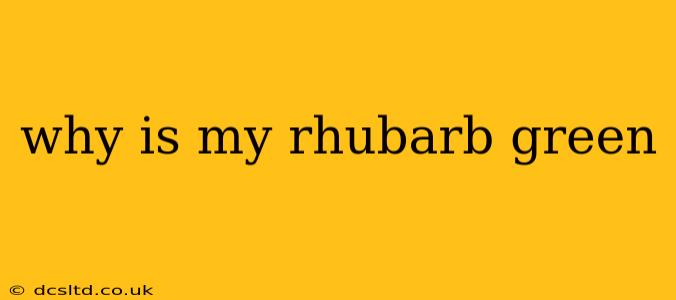Rhubarb, with its tart and tangy flavor, is a beloved ingredient in many spring and summer recipes. But sometimes, instead of the vibrant red stalks we expect, we find our rhubarb plants producing green stalks. This can be puzzling for home gardeners, leading to questions about the plant's health and the quality of the harvest. Let's explore the reasons behind green rhubarb stalks and what you can do about it.
Why is my rhubarb green instead of red?
The color of your rhubarb stalks is primarily determined by the variety of rhubarb you're growing and the amount of sunlight it receives. Some varieties are naturally green, while others are red or even a mix of both. However, even red varieties can produce greener stalks under certain conditions. Insufficient sunlight is a common culprit. Red rhubarb varieties require ample sunlight to develop their rich red color. The more sunlight they get, the more anthocyanins, the pigments responsible for the red color, they produce.
What kind of rhubarb do I have?
Identifying your rhubarb variety is the first step. Many heirloom and newer varieties naturally produce green stalks. If you planted a green variety, the green color is perfectly normal, and there's no need for concern. Check the plant label or seed packet for details on the variety. If you're unsure of the variety, research images of common rhubarb varieties online to compare your plant's characteristics.
Does sunlight affect rhubarb color?
Yes, sunlight is a crucial factor. Insufficient sunlight can lead to paler, greener stalks even in red varieties. Rhubarb thrives in full sun (at least 6-8 hours of direct sunlight daily). If your rhubarb is planted in a shady location, it's likely to produce greener stalks. Consider transplanting it to a sunnier spot for a more vibrant red color in future harvests.
Is my soil affecting the rhubarb color?
Soil conditions play a less significant role than sunlight in rhubarb color. While healthy soil is crucial for overall plant health, the color is largely determined by genetics and sunlight exposure. Ensure your soil is well-drained and fertile, providing the nutrients rhubarb needs for healthy growth.
Could it be a disease or pest issue?
While unlikely to cause green stalks directly, diseases and pests can weaken the plant, affecting its overall health and potentially reducing its ability to produce vibrant red color. Inspect your plant for signs of disease or pest infestation. Look for unusual spots, discoloration, wilting, or insect activity. Addressing these issues will promote healthier growth, but it won't necessarily turn green stalks red.
Can I still eat green rhubarb?
Absolutely! Green rhubarb is perfectly safe to eat. It may have a slightly milder flavor compared to red rhubarb, but its nutritional value remains essentially the same. Many recipes work equally well with green rhubarb.
How can I improve the color of my rhubarb next year?
For red varieties, focus on increasing sunlight exposure. If your rhubarb is currently in a partially shaded area, consider transplanting it to a location with more sunlight. Ensure your soil is well-drained and fertile by amending it with compost or other organic matter. Proper soil conditions will help the plant thrive and potentially improve the color of the stalks. Remember, some varieties naturally produce green stalks, and that's perfectly acceptable.
By understanding the factors that influence rhubarb color, you can enjoy a healthy and delicious harvest, regardless of whether your stalks are green, red, or a combination of both. Remember to always check for diseases and pests and ensure your plants receive plenty of sunlight for optimal growth and potential color development.
